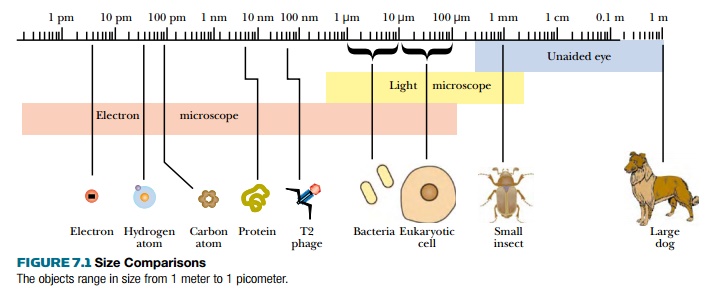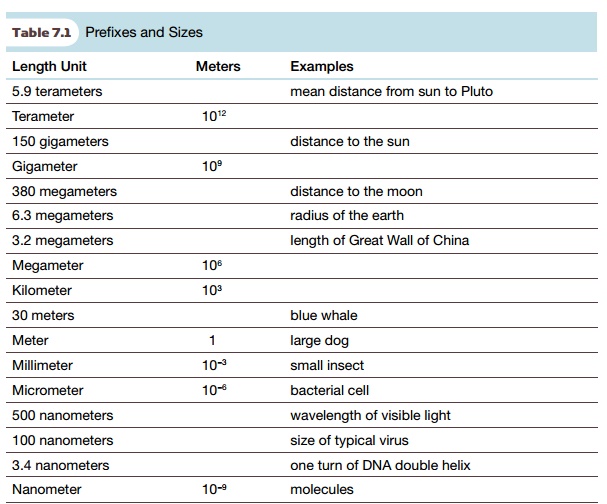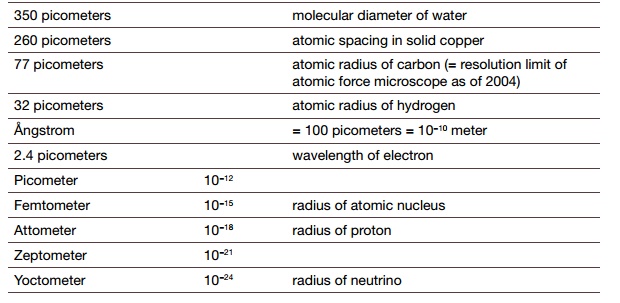Chapter: Biotechnology Applying the Genetic Revolution: Nanobiotechnology
Nanobiotechnology
Nanobiotechnology
INTRODUCTION
In 1959, Richard Feynman was
the first scientist to suggest that devices and materials could someday be
fabricated to atomic specifications: “The principles of physics, as far as I
can see, do not speak against the possibility of maneuvering things atom by
atom.”
Molecular biology originated
largely from the study of microorganisms. One micrometer is one millionth of a
meter, and cells of Escherichia coli,
the geneticist’s favorite bacterium, are roughly 1 micrometer (= “micron”) in
length. A nanometer is one thousandth of a micrometer = 10−9 meters
(Fig. 7.1). The terms micro- and nano- are both from Greek.

Mikros means “small.” More imaginative is nanos, a little old man or dwarf. Pico- comes from Spanish
where it means a small quantity, or beak
(from Latin beccus, “beak,”
ultimately of Celtic origin). Prefixes for even smaller quantities are shown in
Table 7.1. As far as length is concerned, these are applicable only to
subatomic dimensions. Nevertheless, when dealing with masses and volumes on the
nanoscale we may find femtograms and zeptoliters.


Recently, science has
advanced into the area of nanotechnology.
As the name indicates, the impetus has come from pursuing practical
applications, especially in the fields of electronics and materials science,
rather than a quest for theoretical knowledge. Nanotechnology involves the
individual manipulation of single molecules or even atoms. Building components
atom-by-atom or molecule-by-molecule in order to create materials with novel or
vastly improved properties was perhaps the original goal of nanotechnologists.
However, the field has expanded in a rather ill-defined way and tends to
include any structures so tiny that their study or manipulation was impossible
or impractical until recently. At the nanoscale, quantum effects emerge and
materials often behave strangely, compared to their bulk properties.
The internal components of
biological cells are on the same scale as those studied by nanotechnology. As a consequence,
nanotechnologists have looked to cell biology for useful structures, processes,
and information. Cellular organelles such as ribosomes may be regarded as
programmable “nanomachines” or “nano-assemblers.” Thus nanotechnology is
spilling over into molecular biology. Much of “nanobiotechnology” is in fact
molecular biology viewed from the perspective of materials science and
described in novel terminology.
All chemical reactions
operate at a molecular level. What distinguishes true nanotechnology is that
single molecules or nanostructures are assembled following specific
instructions.
A ribosome does not merely
polymerize amino acids into a chain. It takes specified amino acids, one at a
time, according to information provided, and links them in a specific order.
Thus the critical properties of a nanoassembler include the ability not only to
assemble structures at the molecular level but to do so in a specific and
controlled manner.
The main practical objectives
of nanobiotechnology are using biological components to achieve nanoscale
tasks. Some of these tasks are nonbiological and have applications in such
areas as electronics and computing, whereas others are applicable to biology or
medicine. The purpose of this chapter is to show, by selected examples, how
biological approaches can contribute to nanoscience.
Related Topics